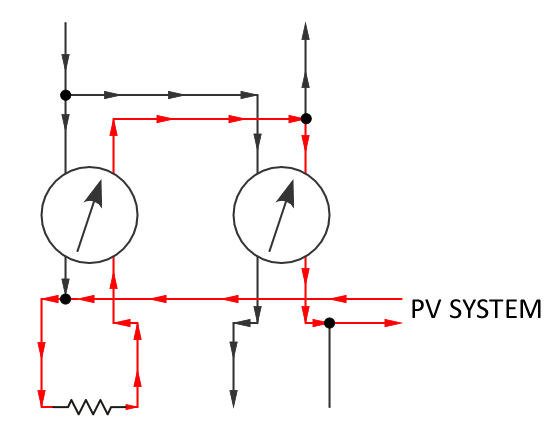- Location
- Placerville, CA, USA
- Occupation
- Retired PV System Designer
Nice diagram!However, in the case I brought up, the 240V load is using all of the PV system's output. Current is in phase with voltage on the meter for the customer with the load...

But rethink it again. The customer with the load does not pay anything (if the load current exactly equals the PV current.) This is the normal situation where the PV power (or half the PV power in this case) just balances out the load. The meter reads zero because the load is being supplied by the PV.
On the other side take a close look at your voltage and current directions and I think you will see that the meter there is in fact running backwards, so that customer gets credit for his 1/2 of the PV power.
If neither customer has a load, each of them gets meter credit for backfeeding 1/2 of the PV output. If both customers have loads equal to the PV current, both meters read zero. And the load is being run "for free" just as we would expect.
A little more explanation: Since you are showing a 240 volt load which is drawing the full PV current (assuming that in your diagram only the red wires have non-zero current), the load is using the full power equivalent of the PV output, not just one half of it. So the return current on the right conductor of the load customer, without the matching current on the left hand wire, will result in 1/2 of the load power being metered as consumed.
On the non-load customer side, there will be current coming back through the corresponding phase conductor without a matching current in the other phase, so again 1/2 of the load power amount will be counted, but it will be counted as supplied to the grid, not as drawn from the grid.
One meter reads zero, the other reads a credit of PV/2. All exactly as it should be.
Again, the only potential problem is if the meters are built in such a way that a net unbalanced current flow (counting both phases and the neutral which is not shown) will not be metered properly.
Just look at one thing to start off: The direction of the current in the right-hand phase line in the two meters is opposite. So whatever one meter reads as delivered, the other will read as received.
Last edited:

